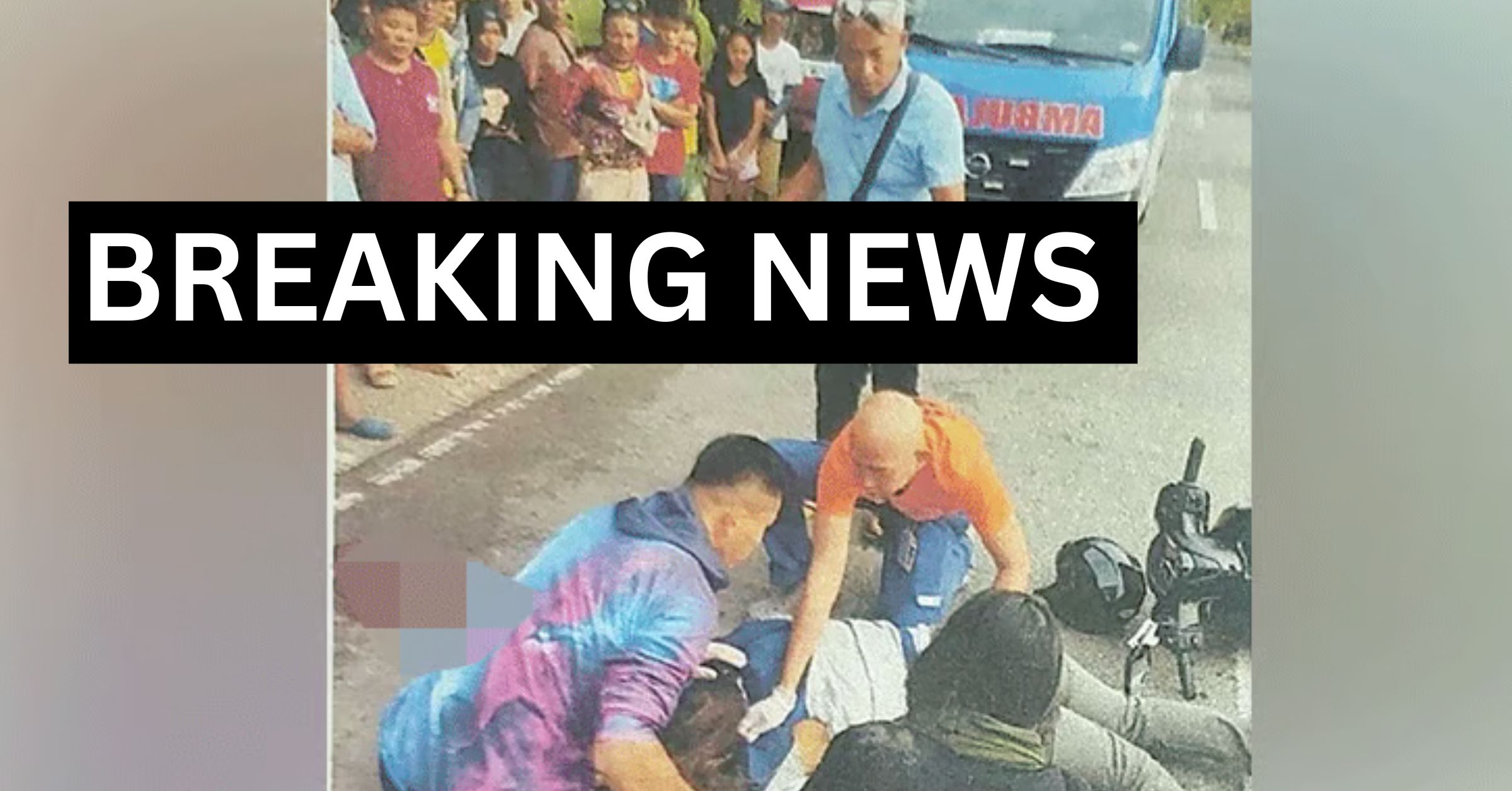By several accounts, Brigida Gerzon was a diligent student and great friend. One of her former blockmates at the Cebu Normal University (CNU) said Gerzon, known to those close to her as Brige, excelled in their journalism subjects. Her former teacher, The Freeman Sports Editor Emmanuel Villaruel, called her sweet and said she was always ready to answer his questions in class.
The tragedy of her early death in a motorcycle accident last January 13, 2024 in Alegria is exacerbated by the reporting of dyHP radio reporter Paul Lauro, who calls himself the “king of breaking news.”
Breaking news
Brige, according to Superbalita Cebu, was driving the motorcycle with her older sister, Gecel, riding pillion when the car ahead of them suddenly slowed down to avoid a pothole. The motorcycle hit the car and they were thrown into the opposite lane, in the path of a vehicle of the St. Peter Funeral Homes. Brige was killed when the vehicle ran over her.
Lauro broke the news in his typical all capitals post: ANGKAS SA MOTOR NGA BABAYI UG TOMBOY NGA MAOY DRIVER SA MOTOR ANG NAANGOL HUMAN MAAKSIDENTI …
It is that detail that her family and friends find hurtful. There is certainly nothing wrong in being a tomboy but Brige wasn’t one, her friends said. In a place like Cebu, being labeled a homosexual subjects one to ridicule and even condemnation.
“Apparently, some reporters don’t know what to use and what to omit out of the info from the police,” said retired Sun.Star Cebu and Superbalita editor-in-chief Pachico A. Seares, who writes a column about the media.
That detail isn’t in the police report. Lauro said in an interview over Facebook Messenger that he got it from a trusted source.
Not needed in story
A veteran journalist who has been working in Cebu media for decades said that information was not needed in the report. The journalist said reporters would often make fun of the subjects of their police stories just for engagement.
“Unya og dato na ang suspect, matawag na ninyo nga kawatan? Di kaha mo ikiha?” the journalist said in an interview. (Would you call a rich suspect a thief? You’d get sued!)
Another veteran journalist who is also a lawyer and mass communications teacher said the family can file a civil case for damages against Lauro to teach him a lesson.
“Calling her something she’s not. Although being a tomboy is not a crime. But if the family feels nga na defame siya and damaged her reputation, they can sue for damages in a civil case. My thoughts,” the lawyer said.
Lauro said he will no longer talk to the family because relatives have threatened him.
Another thing that her family and friends find hurtful was the comment by businessman Henry Llaguno of Henry’s Lechon who mentioned how it was timely that the vehicle that ran over her was owned by a funeral parlor.
“Ikarga na lang diretso sa morgue,” Lauro replied to Llaguno’s comment. (Her body can be directly brought to the morgue.) Llaguno then made a cavalier generalization of “mga kamote rider mana.” (Those are reckless drivers.)
Lack of sympathy
The cruelty by Lauro and Llaguno in their hurtful comments, whether intentional or not, is really stunning in their lack of sympathy.
“Be careful in posting stories on accidents even if it’s for breaking news, especially nowadays nga naa nay social media. Consider the sensitivities and sensibilities of the netizens, esp. the families of those involved,” another veteran journalist told me over Facebook Messenger. He asked not to be named because he is close to the media personalities involved.
“Need ning klase sa mga reporter to know about communication ethics. Importante kaayo nga kahibawo sila ana bisan basic lang,” said longtime reporter Dr. Joseph Tubilan, who has a doctorate in communications and is a top official at CNU. Tubilan also teaches journalism.
“Ingon ana nga cases they should treat it with sensitivity, prioritize verified information, and avoid sensationalism. Upholding ethical standards, respecting the privacy of those affected, and providing accurate updates without speculative details are crucial aspects of responsible journalism sa ingon ana nga situation ilabi na kanang mga namatay nga dili na intawon makatabi,” Tubilan said.
And while it is a mark of a good journalist to be receptive to corrections, Lauro would have none of those. He was hostile to those who called him out. Lauro even told one commenter that if he met an accident, he would make sure to get the details right.
Lauro would later edit the report but, as Villaruel puts it, “the damage has been done.”
Discipline of verification
That a news event is still breaking is no excuse to be reckless in reporting. What differentiates reporters from regular Facebook users or those pejoratively called “Maritess” if not the fact that journalists verify information?
“The discipline of verification is what separates journalism from entertainment, propaganda, fiction, or art,” said Bill Kovach and Tom Rosenstiel in “The Elements of Journalism.” “Journalism alone is focused first on getting what happened down right.”
But what Lauro did is symptomatic of the decline in reporting in Cebu as with any other place in today’s media environment. Journalism is now set aside to chase clicks and engagement. It’s a hard fact to accept but that’s the reality – some newsrooms have become mere content factories.
That’s the reason why police reports are what they are, sometimes ridiculing the subjects or written in such a way as to enrage people, because reporters and newsrooms are after engagement.
With engagement becoming the key metric to measure “journalistic” performance, you end up with what a veteran journalist described as “gutter reporting” that you see and read today. They accentuate the bizarre, they highlight the enraging, to encourage engagement.
Arnold Bustamante, another dyHP reporter, posted about an interview of the confessed killer of voice coach Jay Unchuan. In his update on Facebook, Bustamante included lurid sexual details that led to the killing. Because of these details, which could have been omitted, people ridiculed and made fun of Unchuan in the comments on the post.
“The sexual details have no place in a news report. What led to the killing can be told without the specifics on sexual demands,” Seares said about Bustamante’s post.
Bustamante’s updates on the case that he posted on his page contrast sharply with how his editors at Sun.Star Cebu and Superbalita Cebu handled the story – delicately and with compassion.
Even the press release published by the police was more compassionate.
But both reports in question, that of Lauro and Bustamante, are in their personal accounts, not of their media organizations.
Clarify rules
Bustamante’s post is more egregious considering his status as president of the group of beat reporters in Cebu. He should know better. That lack of empathy is exacerbated by the fact that he himself had a run-in with the law and his booking photos were released by police. Bustamante is privileged to be a member of the media and so, as expected, got favorable treatment and coverage.
In a gathering of the Cebu-Citizens Press Council last year, I raised this issue to the panel – how unfair the media can be to subjects of police reports and how hypocritical they are with their treatment of one of their own.
Seares said the remedy is to “clarify the rules and adopt some kind of review for news posted personally by the reporter or kores, or with/in the name of the news outfit.”
While the two posted on their personal accounts, Seares said they are closely identified with their radio station, dyHP.
I think the remedy is even more basic – for journalists to not lose their humanity in chasing engagement. They should treat subjects of police reports the same way that they treated one of their own, with compassion, dignity, and presumption of innocence.
Max is a journalist and blogger based in Cebu. He has written and edited for such publications as The Freeman, The Independent Post, Today, Sun.Star Cebu, Cebu Daily News, Philstar Life, and Rappler.
He is also a mobile app and web developer and co-founded InnoPub Media with his wife Marlen.


Leave a Reply